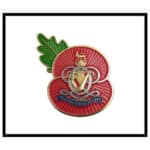The Second World War
Initially during the “Phoney War” the 3rd Hussars were brigade in the 1st Armoured Brigade alongside their old friends The 4th Hussars. After France had fallen the Regiment was sent to Cairo to join The 7th Armoured Brigade of 7th Armoured Division, “The Desert Rats”.
Why not discover about the Western Desert campaign, 1940-42.
Buq Buq, 11 December 1940
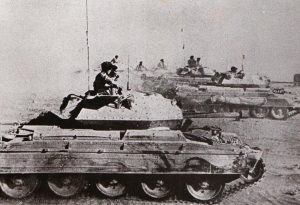
A Squadron 3rd Hussars Crusaders advance
The 3rd King’s Own Hussars and the 8th King’s Royal Irish Hussars were both in the 7th Armoured Brigade at the time of the British assault against the Italians in the Western Desert.
Initially, the Brigade was in reserve for the first few days, coming into the battle after Sidi Barrani had been taken. The 8th was detached to ensure the enemy from the south did not come to the aid of those being attacked in the north, whilst the 3rd with the rest of the Brigade attacked and overran the enemy camp at Buq Buq.
In the ensuing pursuit the lead Squadron suddenly became bogged in a salt marsh within close range of the Italian anti-tank guns, and within ten minutes had lost thirteen tanks to heavy fire.
The 8th was detailed to destroy these guns and coming in from behind them, charged them at full speed. A lucky shot at the enemy’s ammunition truck knocked out their will to fight and they promptly surrendered.
The Brigade captured 14,000 Italians and managed to seal off the enemy’s escape from Sidi Barrani.
Beda Fomm, 5-8 February 1941
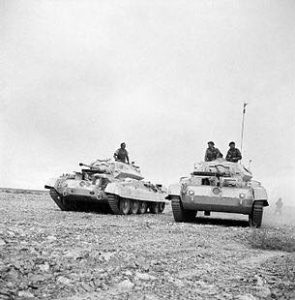
3rd Hussars, Western Desert
Both The 3rd King’s Own Hussars and the 7th Queen’s Own Hussars played leading roles with the 7th Armoured Division in this final and decisive battle against the Italians in North Africa.
The latter were trying to pull their forces out of Benghazi and to cut them off involved a mad dash across 150 miles of difficult country.
When the 3rd and the 7th reached the coastal road leading south out of Benghazi at Beda Fomm they came across “five miles of a London traffic jam” and the Division captured over 20,000 prisoners, 112 tanks, 216 guns and 1,500 lorries.
In April 1941 the Afrika Corps under Rommel attacked and pushed the Allies all the way back to the El Alamein Line in twelve months.
Meanwhile, the Regiment had been split up, with ‘C’ Squadron moving to Crete before it fell and ‘B’ Squadron sent to Java where they were captured by the Japanese and put into the infamous prisoner-of-war camps.
The Battle Of Crete, 20 May – 1 June 1941
‘C’ Squadron, The 3rd King’s Own Hussars fought in the defence of Crete against the massive German air and sea invasion of 20 May 1941.
Why not find out more about the campaign in Greece and Crete.
Although fairly equal in numbers on land and sea the Germans had total air superiority and used it with devastating success.
Despite a spirited resistance by pockets of troops all over the island, after ten days the situation was hopeless and the order to evacuate was given on 30 May.
‘C’ Squadron destroyed all its remaining tanks and was evacuated to Alexandria.
Sidi Suleiman, 15-17 June 1941
During the siege of Tobruk the British made numerous attempts to relieve the fortress, but each time the Germans would bring up heavy armour in strength and the operation would have to be called off.
A composite Squadron of The 3rd King’s Own Hussars was heavily involved in fighting around Halfaya and Sidi Suleiman on one of these operations.
The remaining and reconstituted 3rd Hussars were re-equipped with Crusader, Sherman and Grant tanks ready for the battle ahead.
Dutch East Indies – January 1942
A few days after the surrender of Hong Kong to the Japanese, the Regiment received orders to provide one squadron at full strength, for ‘service overseas’. ‘B’ Squadron was chosen, the Squadron had 18 Vickers Mark VIb and VIc light tanks, including three reserve vehicles, and Maj William-Powlett was allowed to pick the men to go with him.
The seven officers and 138 NCO’s and men left their base in Cyprus for Egypt on January 7, 1942, and at the end of the month, they sailed through the Suez Canal, towards the Dutch East Indies.
Their goal was Singapore, but they were too late to reach it. On February 15, 1942 – two days after the 3rd Hussars squadron reached the island of Sumatra – Singapore surrendered.
Major William-Powlett sought guidance from GHQ. He was ordered to unload his tanks and immediately occupy the two airfields in the Palembang area; the tanks were to go by train, the crews by road.
Japanese paratroopers landed at Palembang P1 in the early morning of February 14 and it was obvious that, long before the tanks could get there, Palembang would be occupied.
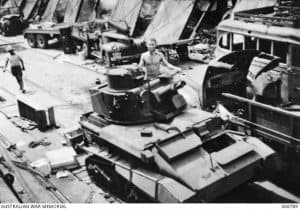
3rd Hussars tanks at Tanjong Priok quayside, February 1942
So, on February 15, when all tanks, trucks and stores had been unloaded, GHQ ordered the 3rd Hussars to load everything back onto S.S. Hermion, embark the troops and head for Java! Unfortunately, the ship had already left (buzzed off to a safer place, as some said) and it took them until the next day to find transport, a small steamer called ‘Silver Larch’.
Its derricks could handle the tanks but not the heavy ammunition lorries and most of them had to be left behind. Working deep into the night, they loaded ten tanks on the ‘Silver Larch’ and eight on a lighter towed by a Dutch tug.
Around 04.00 on February 17, the ships left Oosthaven, with all tanks, 80% of the transport vehicles but only 25% of the ammunition on board. Six hours later, the ships docked at Merak, a small port at the extreme western end of Java, just across Sunda Strait. After debarking most of the Hussars and other troops, the ships sailed on to Tanjong Priok, the port of Batavia. There, a team of 30 Hussars would unload the tanks and vehicles for the second time.
The main body of the 3rd Hussars had gone by train to Batavia which they reached on the night of the 18th. The CO assembled them in the station forecourt and told them to wait while he went in search of a Transport Officer. When he finally had found one, his troops had disappeared; an over-zealous Dutch officer had ‘discovered’ them and sent them to barracks at the outskirts of Batavia, of course not the ones they were supposed to go to.
While this problem was being unravelled, Major William-Powlett received the alarming news that ‘Silver Larch’ had been ordered to leave the port immediately. It took some fairly dramatic pleading at naval headquarters to get permission to complete the unloading of his tanks and vehicles.
Major William-Powlett next had a look at the countryside he was supposed to operate in. It was absolutely unsuitable for this type of tank; swampy rice paddies interspersed with patches of light jungle, with only a few roads and some muddy tracks, and the radios, when tested proved to be totally inadequate.
The Japanese 26th Army invaded West Java on March 1, 1942, and moved rapidly toward Batavia and Bandung. The order to withdraw was given.
Before withdrawing on the morning of March 5, a unit of the 3rd fought off and killed about a dozen of a strong Japanese patrol that had come cycling down the Semplak-Buitenzorg road. The 3rd Hussars disengaged and reached Bandung on March 6. Major William-Powlett learned that the Dutch were about to capitulate. Plans were made for the British and Australian troops to move south over the mountains.
But when the Dutch surrendered on March 8, Major William-Powlett knew that there was no hope of further action against the enemy, and he had to obey a written order from General Sitwell to destroy his tanks. They did this by sending them tumbling down a ravine into a strongly flowing river.
It turned out that 60% of the men wanted to ‘walk home’ and they started off during the night. But none of them escaped from Java. The seaworthy boats on Java’s south coast had been destroyed by the Dutch, and by March 28, most of them were together again – in the Prison compound near Bandung.
They had to endure three and a half years of captivity.
Discover about the men who were held in captivity.
El Alamein, 23 October – 4 November 1942
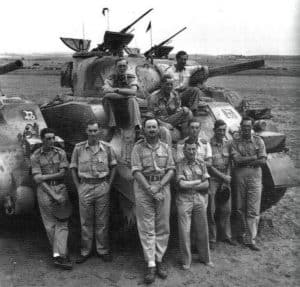
Officers A Sqn 3rd Hussars
In the first phase of El Alamein, the Regiment helped break through Rommel’s defences but in the second phase, it was given the crucial task of forcing a gap through the remaining defences to enable the armoured reserves to break through.
The “Moodkee Wallahs” succeeded and Alamein was won, at the cost of 21 Officer casualties, and 98 Other Rank casualties whilst of their 51 tanks, 47 were destroyed in the battle.
So devastated was the Regiment that it was unable to join the pursuit. General Freyburg granted The 3rd the honour of wearing the Fern Leaf on their vehicles because of their participation with the New Zealand Division during the battle.
In January 1943, they moved to Aleppo in Syria, in August to Haifa and thence to Lebanon but it was not until April of 1944 that they were put back into action pushing the Germans out of Italy.
In June and July, The 3rd led the advance of The 78th Division up Italy reaching Citta del Piave and fighting then at Ripa, Montone, Citta de Castello and Pistrino in the Tiber valley.
Citta del Piave, 16-19 June 1944
The 3rd King’s Own Hussars fought against elite German paratroopers from Orvieto to Citta del Piave in Italy in 1944. In the latter, they were ordered to attack with only one Squadron against an enemy that had been reinforced overnight.
They encountered heavy anti-tank and bazooka fire in the narrow streets but together with the 1st East Surreys and the 5th Buffs, they drove the enemy from the town after two days of hard fighting.
Citta Di Castello, 16-22 July 1944
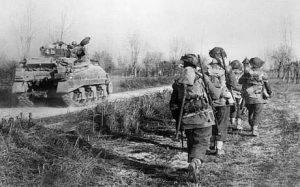
The 3rd Hussars advancing in Italy
The 3rd King’s Own Hussars effectively fought a “private battle” at Citta Di Castello when they had to push the enemy of a feature that dominated the approaches to the Tiber Valley near the town.
At first light on the 21st, they quietly forded a river and came upon the Germans from an unexpected angle. They fought all day, taking out gun pits one at a time until they had completely cleared the objective.
It was the only time in the whole Italian campaign that a strongly held major town was assaulted and captured by tanks with no infantry support.
Why not discover about the campaign in Italy, during 1943-45.
The Regiment had led 130 miles of successful pursuit when an order came that all personnel who had served overseas for four and a half years were to be sent back to England.
This was disappointing as the Regiment had always suffered the brunt of the battles but rarely enjoyed the easier work of the pursuits.
The 3rd King’s Own Hussars moved to Syria first and this is where they were for the capitulation of the Axis powers on 6 May 1945.
When Japan surrendered in August ‘B’ Squadron started to return to the Regiment. The inhuman Japanese prisoner-of-war camps had killed 54 of the Squadron.
Battle Honours
The 3rd King’s Own Hussars were awarded a total of 10 battle honours during this period.
Why not take a look at the story behind each one:
- Sidi Barrani
- Buq Buq
- Beda Fomm
- Sidi Suleiman
- El Alamein
- North Africa 1940-42
- Crete
- Citta Della Pieve
- Citta Di Castello
- Italy 1944
Campaign Medals
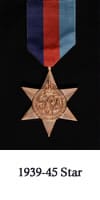
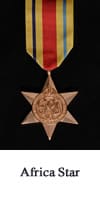
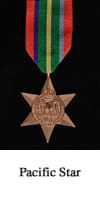
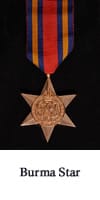
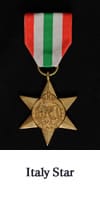
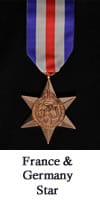

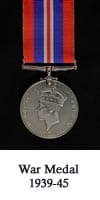
A series of various stars were issued for the campaigns of World War 2. The colours of the ribbons have symbolic significance and are believed to have been designed personally by King George VI.
No more than 5 stars may be awarded to one person. Those who qualify for more are awarded a clasp with the title of one of the stars to which they qualify. The clasp is then attached to the ribbon of one of the other stars.
1939 to 1945 Star. The 1939 to 1945 Star was awarded to personnel who completed operational service overseas between 3 September 1939 and 8 May 1945 (2 Sept 1945 in the Far East).
Africa Star. The Africa Star was awarded to personnel who served in North Africa, Malta or Egypt between 10 June 1940 and 12 May 1943.
Pacific Star: Malaya, Singapore and the Pacific Ocean. The Pacific Star was awarded for operational service in Malaya, Singapore, China, Hong Kong or Sumatra between 8 December 1941 and 2 September 1945.
Burma Star. The Burma Star was awarded for operational service in Burma between 11 December 1941 and 2 September 1945. Those serving in Bengal and Assam in India and China, Hong Kong, Malaya or Sumatra between other specified dates may also qualify.
Italy Star. The Italy Star was awarded for operational service in Sicily or Italy between 11 July 1943 and 8 May 1945. Those who served in Yugoslavia, Greece, Corsica or Sardinia between certain other specified dates would also qualify.
France and Germany Star. The France and Germany Star was awarded for operational service in France, Belgium, Luxembourg, The Netherlands or Germany between 6 June 1944 and 8 May 1945.
The Defence Medal. The Defence Medal is awarded for non-operational services such as those service personnel working in headquarters, on training bases and airfields and members of the Home guard.
War Medal 1939 to 1945. The War Medal was awarded to all full-time personnel of the armed forces wherever they were serving. The medal was granted in addition to campaign stars and the Defence Medal.

